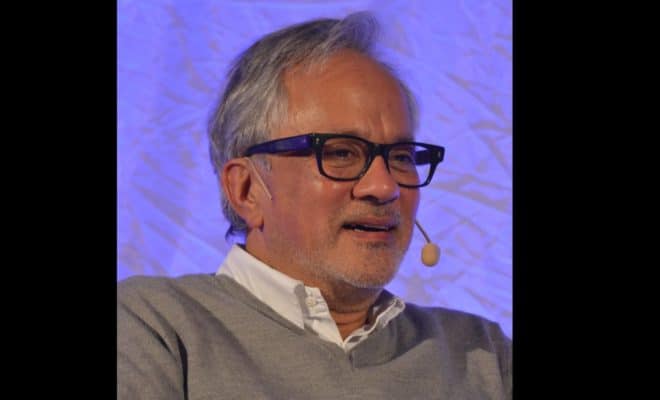Arts
Anish Kapoor, the Sculptor Challenging Perspectives

Anish Kapoor
Photo: Wikimedia Commons
UK-based sculptor Anish Kapoor is now exploring the world of virtual reality in his debut VR art exhibition in Sweden.
The latest artist to experiment with virtual reality is Mumbai-born British citizen Anish Kapoor. He presented his debut art work in the field of virtual reality, titled Into Yourself-Fall, during the Nobel Week in Gothenburg, Sweden, on Dec. 9. The creation is a work in progress expected to be completed in the next few months.
“In it I think of the body falling into itself and turning itself inside out; vertigo as descent inward,” Kapoor said about his latest piece, AFP reported. The famed sculptor, who has the exclusive rights to the blackest black color, also designed the BRIT Awards 2018 recently. The red statuette is a transparent blocky red trophy with the Britannia figure trapped in the center. It was hailed as something that challenges perspectives.
“Sculpture is often a process of positive and negative form,” Kapoor said, reported dezeen.com. “I have made the award using both.”
The Turner Prize-winning 63-year-old sculptor, has himself been honored by both the British and Indian governments — he was honored with the Padma Bhushan in 2012, and received a knighthood in 2013. Kapoor, known as one of the greatest living artists in the world, broke a record in 2009, when his work Untitled received the highest auction price for a single piece in the Middle East. It sold for $1.595 million. Prior to that, Kapoor’s highest auction price for a single piece was in 2008 when his work sold for £1.94 million. His auction turnover is €12.3 million.
He is also known for some rather unusual accomplishments. Kapoor sparked a feud with other artists when he trademarked the blackest black color, the Vantablack pigment, in 2016. By trademarking the color developed by British company NanoSystems, he ensured that nobody else could use it.
Soon after, British artist Stuart Semple trademarked the pinkest pink. The cerise pink hue is available to all artists but Kapoor, who is legally banned from buying it. The customers of the color are made to sign a waiver that says, “You are not Anish Kapoor, you are in no way affiliated to Anish Kapoor, you are not purchasing this item on behalf of Anish Kapoor or an associate of Anish Kapoor.”
However, Kapoor got his hands on the color and took to Instagram to express his anger about the ban.
The revolutionary artist began his career in the 1980s when he made pigment-based sculptures. Born in Mumbai to an Iraqi-Jewish mother and Indian father, he moved to the United Kingdom in the 1970s to study at the Hornsey College of Art and then later at the Chelsea School of Art and Design. The Doon School alumnus exhibited for the first time in India in 2010, at the National Gallery of Modern Art (NGMA) in New Delhi and the Mehboob Studios in Mumbai. Both exhibitions consisted of works from his record-breaking show at the Royal Academy, London, which attracted over 275,000 visitors in less than three months in 2009.
The exhibition also featured some of his early works as well as a few later creations made of steel, including a huge outdoor sky mirror. Kapoor generously used the scarlet hue in his creations made with steel at the exhibition at NGMA in Delhi.

The Arcelor Mittal Orbit from the Games designed by Anish Kapoor and Cecil Balmond.
His love for the both these elements was clearly reflected in the ArcelorMittal Orbit Tower at the Olympic Park in London. The £17 million project was created by Kapoor and Sri Lanka-born British engineer Cecil Balmond.
Along with steel, Kapoor’s creations portray the use of varied elements like sandstone, acrylic, wax and oil, among others.
The most defining feature of his artwork is its access to the public and the meaning it acquires when placed in common space. His Cloud Gate sculpture in Chicago is the most visited artwork in a public space in the world.
“It is not the least of Anish Kapoor’s achievements that he has created an art that is both profound and accessible,” Congress leader Sonia Gandhi had said in 2010, adding that his creations can be enjoyed by young and old alike, and that they draw in the viewer to participate in the work rather than just observing it passively. “To quote his own words, ‘the work itself has a complete circle of meaning and counterpoint, and without your involvement as a viewer, there is no story’,” she added.
Kapoor has also made news for his stance on political and humanitarian issues. In 2015, he created the Holocaust Memorial for the Liberal Jewish Synagogue in London and the candle design for the 70 candles commemorating the 70th anniversary of the liberation of Auschwitz in Britain.
Earlier this year, he expressed his views on the immigration issue, and announced that he would donate his $1m Genesis prize, called the Jewish Nobel prize by Time magazine, to help people who have fled war or persecution.
“I am an artist, not a politician, and I feel I must speak out against indifference for the suffering of others. There are over 60 million refugees in the world today – whatever the geography of displacement, the refugee crisis is right here on our doorstep,” he said in a statement at the time.
“To lose one’s home, one’s land, one’s sense of belonging, is bewildering. All that is left is one’s body … how long before – for so many – even that is lost?
“I believe that in the current political climate the world over, it is more important than ever that we continue to stand against the abhorrent government policies that are an offence against our ethics and the very tenets of what it means to be human. As Jews, we must question whether this reality is closer to home than we might like, and we must condemn the exclusionist policies and politics of the government that claims to represent us.”



